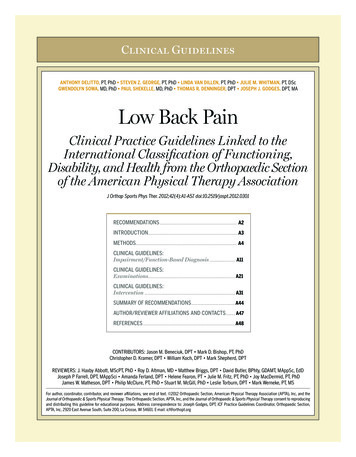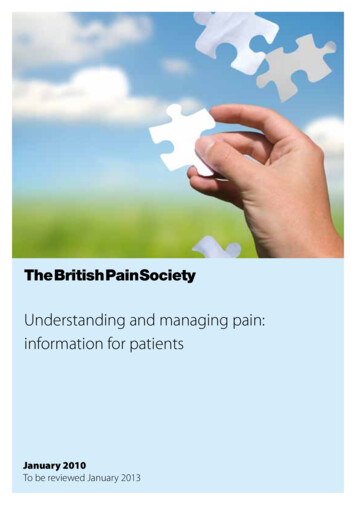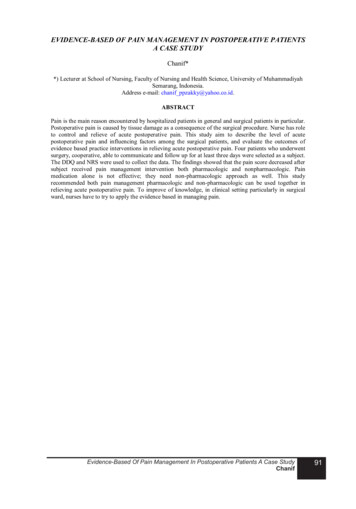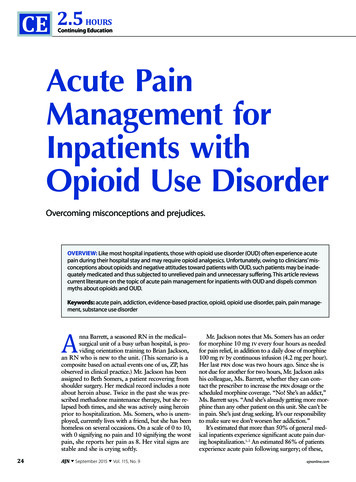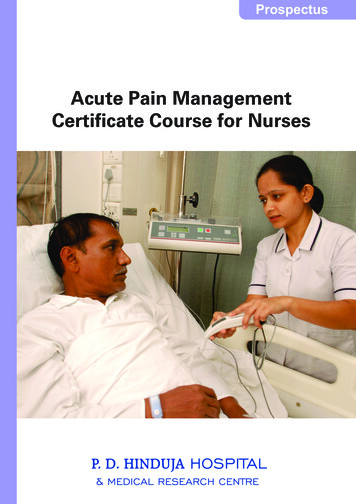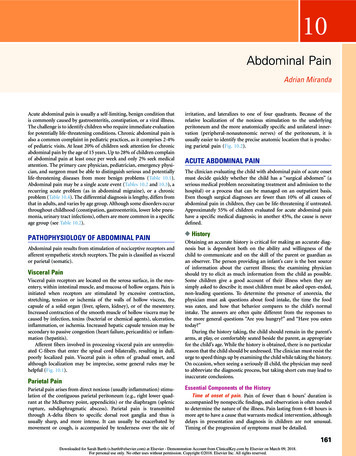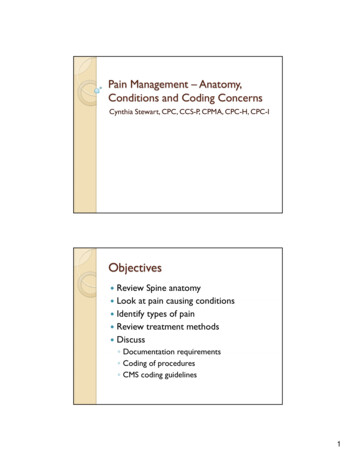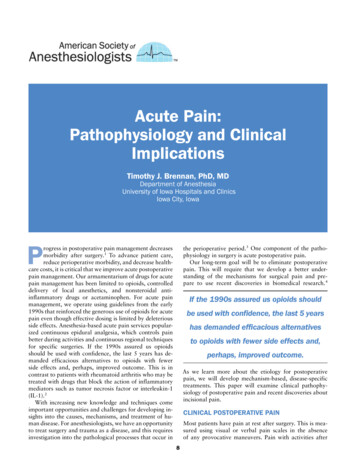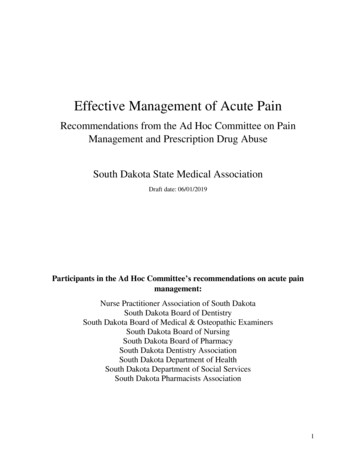
Transcription
Effective Management of Acute PainRecommendations from the Ad Hoc Committee on PainManagement and Prescription Drug AbuseSouth Dakota State Medical AssociationDraft date: 06/01/2019Participants in the Ad Hoc Committee’s recommendations on acute painmanagement:Nurse Practitioner Association of South DakotaSouth Dakota Board of DentistrySouth Dakota Board of Medical & Osteopathic ExaminersSouth Dakota Board of NursingSouth Dakota Board of PharmacySouth Dakota Dentistry AssociationSouth Dakota Department of HealthSouth Dakota Department of Social ServicesSouth Dakota Pharmacists Association1
Table of ContentsExecutive Summary . 3Introduction . 5Types and levels of acute pain . 6Assessing pain. 7Strategies for acute pain control. 10Non-pharmacological treatments for acute pain . 11Pharmacological management of acute pain . 14Opioids for acute pain in opioid-naïve patients . 16Specific acute pain populations. 19Management of acute perioperative pain . 19Management of acute pain in patients already using opioids or on medication-assisted treatment . 21Patients served by multiple providers . 21Emergency department considerations . 22Older adults . 22Pregnancy. 23Conclusions . 24Appendix 1 - Acute Pain Workflow Guideline . 25References . 282
Executive SummaryAlthough the focus of much public and professional attention in the past decade has been on theproblems related to opioid analgesics for treating chronic non-cancer pain, the treatment and managementof acute pain is an equally important topic because many of the same dynamics (e.g., prescribing opioidswhen non-opioids may be just as effective, or prescribing higher doses/durations than needed) are at workwith acute pain as with chronic pain.Properly and responsibly managing acute pain is desirable not only because it relieves patientsuffering, but because it reduces the chances that acute pain will morph into chronic pain, and responsibleprescribing can help stem the tide of opioid diversion, misuse, and abuse. Opioids do, of course, play aninvaluable role in the management of acute pain, but they carry important risks, as well, and thus aregenerally viewed as second-line agents or to be used only as part of a multi-modal approach. The risks ofopioids, even when used for acute pain and for relatively short durations, are amplified among olderadults, patients with impaired renal or hepatic function, those with COPD, cardiopulmonary disorders,sleep apnea, or mental illness, and in anyone likely to combine opiates with other respiratory depressantssuch as alcohol or benzodiazepines.3This white paper summarizes the current evidence for optimal management of acute pain, withthe key recommendations being: Assess the degree of expected or actual pain from an injury, surgery, or procedure Consider patient-related and drug-related factors related to pain and pain relief Use multimodal pain control methods, emphasizing, when appropriate, nonpharmacological methods and non-opioid pharmacotherapy If opioids are deemed necessary, prescribe only an amount to cover the expected pain orrealistic duration of time to a follow-up appointmentoCheck PDMP AWARxE, South Dakota’s prescription drug monitoring program.oScreen for risk factors such as history of substance abuse disorder or mentalillness.oPrescribe only short-acting opioids.oDiscuss with patients safe storage, use, and disposal of opioids.oTaper or discontinue opioids as soon as possible.oRe-evaluate patients if healing does not follow the expected course.Although the practices described in these guidelines are intended to apply broadly, they are notintended to establish a “standard of care.” Providers – to include all prescribers - must exercise their own3
best medical judgment when providing treatment, taking all relevant circumstances into account,including the potential for abuse, diversion and risk for addiction.4
IntroductionAs unpleasant as it is, acute pain serves an important adaptive biological purpose: it alerts us tointernal or external damage or dysfunction in our bodies. Acute pain can provoke a range of protectivereflexes (e.g., withdrawal of a damaged limb, muscle spasm, autonomic responses) that can help the bodyheal. Even brief episodes of acute pain, however, can induce suffering, neuronal remodeling, and can setthe stage for chronic pain.4 Associated behaviors (e.g., bracing, abnormal postures, excessive reclining)may further contribute to the development of chronic pain. An example of this phenomenon is persistentpostsurgical pain (PPP), which is pain persisting beyond the expected healing period. Many commonoperations (e.g., mastectomy, thoracotomy, hernia repair, coronary artery bypass surgery) are associatedwith an incidence of PPP of up to 30-50 percent.5 The intensity of perioperative and postoperative pain isestimated to contribute about 20 percent of the overall risk for transition from acute pain to PPP.6In addition to the purely humanitarian value of reducing or eliminating acute pain, therefore,effectively and aggressively treating acute pain may reduce complications and progression to chronic painstates.7Acute pain is a multidimensional experience that usually occurs in response to tissue trauma, andalthough responses to acute pain may be adaptive, they can have adverse physiologic and psychologicalconsequences (e.g., reduced tidal volume, excessive stress response, or inability to comply withrehabilitation). Acute pain is more difficult to manage if permitted to become severe, so prompt andadequate treatment of acute pain is imperative, with the basic goals of: Early intervention, with prompt adjustments in the regimen for inadequately controlled pain Reduction of pain to acceptable levels Facilitation of recovery from underlying disease or injuryAlthough much attention has been paid in the past decade to the range of problematic issuesrelated to opioid analgesics and chronic pain, many similar issues can be at work in the treatment of acutepain. For example, a number of studies demonstrate increased risk of new persistent opioid use in opioidnaïve patients after having been prescribed opioids for acute pain.8-11 Although the risk of opioid misusein patients prescribed opioids for acute post-surgical or post-procedural pain is relatively small (roughly0.6 percent), the volume of such procedures (approximately 48 million ambulatory surgeries orprocedures in 2010) translates into large numbers of patients (i.e., approximately 160,000) who maydevelop dependence, abuse, or overdose every year.12A related issue with opioid prescription for acute pain is the risk of diversion or inappropriate usefrom leftover pills. Approximately 40-50 percent of those who abuse opioids initially obtain the drugs5
from family members or friends with pills remaining from legitimate prescriptions.13 Many studies havefound excessive levels of routine opioid prescriptions for a range of surgical procedures or emergencydepartment visits for painful conditions.14,15 One study of 1,416 patients in a 6-month period found thatsurgeons prescribed a mean of 24 pills (standardized to 5 mg oxycodone) but that patients reported usinga mean of only 8.1 pills (utilization rate 34 percent).16The South Dakota State Medical Association’s Committee on Pain Management and PrescriptionDrug Abuse has reviewed current literature and existing clinical guidelines in order to articulate thefollowing recommendations for effective and responsible treatment of acute pain, including the use ofopioid analgesics. Although the practices described in these guidelines are intended to apply broadly, theyare not intended to establish a “standard of care.” All prescribers must exercise their own best medicaljudgment when providing treatment, taking all relevant circumstances into account, including thepotential for abuse, diversion, and risk for addiction associated with opioid analgesics.Types and levels of acute painAcute pain is typically defined as pain concordant with the degree of tissue damage and whichremits with resolution of the injury. A more holistic definition is “a complex, unpleasant experience withemotional and cognitive, as well as sensory, features that occur in response to tissue trauma.”17 Thisdefinition captures the multiple levels of effects that pain can have, as well as the fact that cognitive andemotional factors can influence how pain is perceived. The subjective experience of pain (as opposed tothe purely physical phenomenon of nociceptive nerve activation) varies widely in degree (from mild tosevere) and quality (dull, sharp, stinging, burning, throbbing, etc.) and is significantly modulated by suchfactors as: Type of injury or surgical procedure Cultural or ethic factors History of drug or alcohol use History of anxiety or depression Anatomic locationInjuries or procedures involving bones and joints tend to be more painful than those involvingsoft tissues.16 For example, in one study of 5,703 ambulatory surgical patients, those havingmicrodiscectomy were most likely to have severe pain, followed by laparoscopic cholecystectomy,shoulder surgery, elbow or hand surgery, ankle procedures, hernia repair, and knee surgery.18 Variationsin pain levels for different procedures can also be seen in data about the amount of opioids needed to6
control pain. In one study, in which opioid doses were standardized to units of 5 mg pills of oxycodone, 5pills were adequate for patients having partial mastectomy, 10 pills for partial mastectomy with lymphnode biopsy, and 15 pills for laparoscopic cholecystectomy and inguinal hernia repair.19 (Significantly, inthis study, many patients used no opioids, ranging from 22 percent after hernia repair to 82 percent afterpartial mastectomy.) Another study found that in the 3 days post-surgery, patients having wrist or handsurgery used about 7 pills, those having forearm or elbows procedures used an average of 11 pills, andthose having upper arm or shoulder procedures used an average of 22 pills (all pills standardized tooxycodone or hydrocodone 5 mg or codeine 30 mg).16Table 1. Common types of acute pain20TypeSource or ExamplesAcute illnessAppendicitis, renal colic,myocardial infarction Head and neck surgery Chest and chest wall surgery Abdominal surgery Orthopedic and vascularsurgery (back, extremities)Motor vehicle accidentSprain, lacerationFire, chemical exposureBone marrow biopsy, endoscopy,catheter placement, circumcision,chest tube placement,immunization, suturingChildbirth by vaginal delivery orCesarean sectionPerioperativeMajor traumaMinor traumaBurnsProceduralObstetricalAssessing painThe etiology of acute pain, as opposed to chronic pain, is typically straightforward since it isusually associated with some kind of obvious injury, disease process, surgery, or procedure. Nonetheless,it can be helpful to systematically evaluate the pain using pain scales (numerical or visual-analog) toincrease the precision of a patient’s self-report and provide a baseline against which to evaluate analgesiaand/or healing over time. Consider the following steps in assessing acute pain:21Ask the patient to describe the pain using 5 characteristics:a. What makes the pain more or less intense?b. What does the pain feel like? (i.e., dull, throbbing, sharp, pins-and-needles)7
c. Does the pain spread anywhere?d. How severe is the pain?e. Is the pain constant or does it come and go?The answers to these questions can help determine if the pain is nociceptive (i.e., the result ofinjury to bones and muscles) or neuropathic (i.e., the result of injury to peripheral or central nerves).Making this determination is important because neuropathic pain is not particularly responsive to nonsteroidal anti-inflammatory drugs (NSAIDs) or opioids. Other medications such as antidepressants oranticonvulsants may be more appropriate first-line agents for neuropathic pain.As will be detailed later in these guidelines, opioid analgesics should not typically be consideredas first-line agents for acute pain, nonetheless, just when assessing patients in chronic pain, it is importantto evaluate a patient in acute pain for risk of opioid dependence or abuse. Such assessment is notcompletely objective, and opinions differ about which patients should be more rigorously assessed. Somefavor a “universal precautions” approach, in which all pain patients are considered to have some degree ofvulnerability to abuse and addiction and, hence, all patients are given the same screenings and diagnosticprocedures.22 Some patient characteristics, however, do appear to be predictive of a potential for drugabuse, misuse, or other aberrant behaviors, particularly a personal or family history of alcohol or drugabuse.23 Some studies also show that younger age and the presence of psychiatric conditions areassociated with aberrant drug-related behaviors.23Relatively brief, validated tools can help formalize assessment of a patient’s risk of having asubstance misuse problem (Table 2) and these should be considered for routine clinical use.23 For moreinformation on risk reduction strategies, a free onlineThe 4Ps of ScreeningCME is available at www.opioidprescribing.com. Parents – Did any of your parents have aproblem with alcohol or drug use? Partner – Does your partner have a problemwith alcohol or drug use? Past – In the past, have you had difficulties inyour life because of alcohol or other drugs,including prescription medications? Present – In the past month, have you drunkany alcohol or used other drugs – illicit orotherwise?8
Table 2. Tools for Patient Risk AssessmentToolWho Administers?LengthDiagnosis, Intractability, Risk,Clinician7 itemsClinician or patient5 yes/noself-reportquestionsPatient self-report24 itemsEfficacy (DIRE)Opioid Risk Tool (ORT)Screener and Opioid Assessmentfor Patients with Pain, Version 1and Revised (SOAPP, andSOAPP-R)Using state PDMP for patients with acute painA standard part of assessing any patient in acute pain, even if opioid analgesics are not expectedto be immediately prescribed, should be accessing the South Dakota prescription drug monitoringprogram PDMP AWARxE. This can help identify patients at higher risk for opiate overdose or opiate usedisorder, and help determine which patients may benefit from great caution and increased monitoring orinterventions when risk factors are present. Research indicates that most fatal overdoses could beidentified retrospectively on the basis of two pieces of information – multiple prescribers and high totaldaily opiate dosage – both of which are available to prescribers through the PDMP AWARxE.PDMP AWARxE offers point-of-care access to pharmacy dispensing records of controlledsubstances from prescribers. From these, clinicians can quickly assess patterns of prescription drug usethat can be helpful in confirming or refuting suspicions of aberrant behaviors.Information from PDMP AWARxE may also reveal that a patient is being prescribed medicationswhose combinations are contraindicated. By reviewing the PDMP each prescriber can identify otherprescribers involved in the care of their patient. Pharmacies and practitioners that dispense any ScheduleII, III, or IV controlled substances in South Dakota, or to an address in South Dakota, must report suchdispensing to PDMP AWARxE.9
Strategies for acute pain controlLadder of painThe World Health Organization advocates a 3-step “Pain relief ladder” model in which nonpharmacologic or non-opioid approaches are preferred as first-line pain treatment, followed by low-doseor low-potency opioids with or without adjunctive pharmacological or non-pharmacological therapies,and, for moderate to severe pain, higher doses and/or more potent opioids with or without adjunctivetreatment.24 Variations on this model include a “fast-track” approach that skips directly to step 3 forcontrolling intense acute pain, incorporation of “movement” on the ladder both up (when, for example, adisease process worsens) as well as down (in response to healing or remission of symptoms), and addinga 4th step that includes invasive procedures such as nerve blocks, neurolysis, epidurals, and spinalstimulators.25Figure 1. 4-Step Adaptation of WHO analgesic ladderClinicians should bear in mind that the goal of pain treatment is not necessarily zero pain, but alevel of pain that is tolerable and that allows the patient maximum physical and emotional functioningwith the lowest risk of side effects, progression to chronic pain, or misuse or abuse. This requires anadroit balancing of many factors (both patient-related and drug-related). One way to operationalize thisparadigm is with multimodal analgesia, in which several therapeutic approaches, each acting at different10
sites of the pain pathway, are used, which can reduce dependence on a single medication and may reduceor eliminate the need for opioids.26 Using both pharmacological and non-pharmacological interventions,and, if warranted, opioid and non-opioid medications can reduce overall opioid use as well as opioidrelated adverse effects.This approach involves the use of more than one method or modality of controlling pain (e.g.,drugs from two or more classes, or drug plus non-drug treatment) to obtain additive beneficial effects,reduce side effects, or both. These modalities may operate through different mechanisms or at differentsites (i.e., peripheral versus central actions).26 One example of multimodal analgesia is the use of variouscombinations of opioids and local anesthetics to manage postoperative pain. Table 3 summarizes somespecific examples of multimodal therapy; Appendix 1 provides a workflow guidline.Some benefits of multimodal analgesia include earlier ambulation, oral intake, and hospitaldischarge for postoperative patients as well as higher levels of participation in activities necessary forrecovery (e.g., physical therapy).26 Some pain experts advocate revision of traditional postoperative careprograms to include accelerated multimodal postoperative recovery programs.Table 3. Examples of multimodal therapyCombination of AgentsSystemic NSAID plus systemic opioidSystemic NSAID plus epidural opioid and local anestheticSystemic NSAID plus local infiltration of anesthetic plus systemic opioidRegional block plus systemic NSAID plus epidural opioid and local anestheticKetamine plus opioidNon-pharmacological treatments for acute painWhen possible, non-pharmacologic methods should be used, alone or combined with analgesics,to manage acute pain. The degree to which this can be done depends on the severity of pain, availability,and patient preference, but many non-pharmacological approaches can be very effective and their useavoids the potential side effects and risks associated with pharmacological interventions.Non-pharmacologic methods for managing early-phase acute pain:20 Application of cold (standard protocols are icing for 20 minutes every two hours or every10 minutes, alternating with 10 minutes of rest) Compression11
Elevation Immobilization (although recovery from some injuries, such as ankle sprains, may befaster with graduated exercises rather than rest alone)27Non-pharmacologic methods for late-phase acute pain and/or pain prophylaxis Physical therapy Yoga Hypnosis/guided imagery MassagePhysical methods of acute pain management can be helpful in all phases of care, includingimmediately after tissue trauma (e.g., rest, application of cold, compression, elevation) and late during thehealing period (e.g., exercises to regain strength and range of motion). Mind/body or psychologicaltherapies can encourage active patient participation in their care, address psychological or socialdimensions of pain, and can support sustained improvements in pain and function with minimal risks.These therapies are not always, or fully, covered by insurance, and access and cost can be barriers, but formany patients, non-pharmacologic management can be used even with limited access to specialty care. Arandomized trial comparing patients assigned to low-cost group aerobics vs. more expensive individualphysiotherapy and muscle reconditioning sessions found similar reductions in low back pain intensity,frequency, or disability.28 Low-cost options to increase physical activity include brisk walking in publicspaces or use of public recreation facilities for group exercise.Cognitive behavioral therapy (CBT) can help address psychosocial contributors to pain and hasbeen shown to improve function.29 Primary care clinicians can integrate elements of CBT into theirpractice by simply encouraging patients to take an active role in their care plan, by supporting patients inengaging in beneficial activities such as exercise, or by providing education in relaxation techniques andcoping strategies. There may be free or low-cost patient support, self-help, and educational communitybased programs in more populated areas of South Dakota that can provide stress reduction and othermental health benefits. Patients with more entrenched anxiety or fear related to pain, or other significantpsychological distress, can be referred for formal therapy with a mental health specialist.Multimodal therapies should be considered for patients not responding to single-modalitytherapy, and combinations should be tailored depending on patient needs, cost, and convenience.Additional details on some common non-pharmacological treatments shown to be effective in managingacute pain follow.12
Physical therapyPhysical therapy may be useful for a range of musculoskeletal issues and can be helpful inrecovering from acute pain-producing traumas initially treated with other methods. A 2018 studyreported that patients with low back pain who first consulted a physical therapist were less likely toreceive an opioid prescription compared to those who first saw their primary care provider.30 Physicaltherapists typically create individualized exercise, stretches, and body alignment adjustments to help relaxtight muscles, decrease back and joint pain, and improve range of motion. Professional guidelines havestrongly recommended aerobic, aquatic, and/or resistance exercises for patients with osteoarthritis of theknee or hip31 and maintenance of activity for patients with low back pain.32YogaYoga involves poses with a range of extensions and challenge, which can be tailored to anindividual’s level of flexibility, strength, and conditioning. Moderate evidence suggests that yoga canreduce late-stage acute pain, as well as chronic pain conditions, particularly back pain. For example, a2017 trial randomized 131 patients (mean age 75) with lower extremity osteoarthritis to twice-weeklysessions of chair yoga vs. a health education program.33 At 3-month follow-up, participants in the yogagroup showed greater reductions in pain interferences (P 0.01) compared to control.30 During theintervention, patients in the yoga group had reduced pain and improved gait speed compared to thecontrol group. In addition to reducing pain, the people in the yoga group were more likely to have stoppedtaking pain relievers at one-year follow-up.MassageMassage therapy may help relieve muscular pain (acute or chronic) as well as reduce stress andanxiety. Some massage therapists specialize in working with people recovering from injuries or surgeries,or they may have focused training for treating particular conditions such as back or neck pain. A reviewof seven randomized trials with 352 participants suggests that massage as a stand-alone treatment may bebetter than no treatment for reducing pain.34 The trials were diverse with respect to outcomes, massagetechniques, and patient populations. Clinical effect sizes for pain were moderate with about a 20-pointreduction in pain scores from a baseline of 50-60 points. The functional benefits were less clear; sometrials showed no benefit while others showed improvement in the 50-foot walk test.A 2011 study randomized 401 adults with back pain to two types of weekly massage (structuraland relaxation) for 10 weeks vs. a usual care group. At the end of the study 36 percent of the adultshaving structural massage and 40 percent of the adults having relaxation massage reported that their painwas “much better” or “gone” vs. 4 percent of the control group.3513
HypnosisClinical hypnosis is a procedure in which a trained clinician or therapist gives a patient a series ofverbal instructions with the goal of helping the patient enter a state of deep relaxation. In this relaxedstate, the patient is aware of everything that is going on, but at the same time, becomes increasinglyabsorbed in using his or her imagination as directed by the therapist. Therapists often teach their patientsself-hypnosis methods that they can employ on their own to reinforce and continue the process at home.Evidence-based research on the use of hypnosis to relieve pain is limited, but a large, welldesigned study, however a 2000 trial evaluated the effectiveness of hypnosis—termed “nonpharmacologicanalgesia”—in easing pain and anxiety in people who were having minimally invasive surgical therapiessuch as angiograms, angioplasty, simple kidney procedures, or liver biopsies, during which they remainedconscious.36 Patients participated in a self-hypnosis relaxation session that involved deep-breathing andconcentration techniques. The researchers found that these patients required less than half the amount ofanalgesic drugs compared to those receiving standard treatments. Procedures also took less time for thehypnosis group, and participants had lower levels of anxiety and pain at both one hour and four hours intothe procedure.Pharmacological management of acute painMost acute pain is nociceptive and responds to non-opioids and opioids. However, some adjuvantanalgesics (e.g., local anesthetics) also are used to manage acute pain and medications for neuropathicpain are also important agents in the analgesic armamentarium. In general, mild-to-moderate acute painresponds well to oral non-opioids (e.g., acetaminophen, NSAIDs, and topical agents). Moderate to severeacute pain is more likely to require opioids, although, as mentioned earlier, lower doses and shortdurations may be appropriate.NSAIDs and acetaminophenNSAIDs, which include aspirin and other salicylic acid derivatives, and acetaminophen are usedin the management of both acute and chronic pain such as that arising from injury, arthritis, dentalprocedures, swelling, or surgical procedures. Although they are weaker analgesics than opioids,acetaminophen and NSAIDs do not produce tolerance, physical dependence, or addiction and they do notinduce respiratory depression or constipation. Acetaminophen and NSAIDs are often added to an opioidregimen for their opioid-sparing effect. Since non-opioids relieve pain via different mechanisms thanopioids, combination therapy can provide improved relief with fewer side effects.14
These agents are not without risk, however. Potential adverse effects of NSAIDs includegastrointestinal problems (e.g., stomach upset, ulcers, perforation, bleeding, liver dysfunction), bleeding(i.e., antiplatelet effects), kidney dysfunction, hypersensitivity reactions and cardiovascular concerns,particularly in the elderly.37 The threshold dose for acetaminophen liver toxicity has not been established;however, the SDSMA recommends that the total adult daily dose should not exceed 3,000 mg in patientswithout liver disease (although the ceiling may be lower for older adults).38The Food and Drug Administration (FDA) currently sets a maximum limit of 325 mg ofacetaminophen in prescription combination products (e.g., hydrocodone and acetaminophen) in anattempt to limit liver damage and other potential ill effects of these products.32Topical agentsTopical capsaicin and salicylates can both be effective for short term pain relief and generallyhave fewer side effects than oral analgesics, but their long-term efficacy is not
the stage for chronic pain.4 Associated behaviors (e.g., bracing, abnormal postures, excessive reclining) may further contribute to the development of chronic pain. An example of this phenomenon is persistent postsurgical pain (PPP), which is pain persisting beyond the expected healing period. Many common
